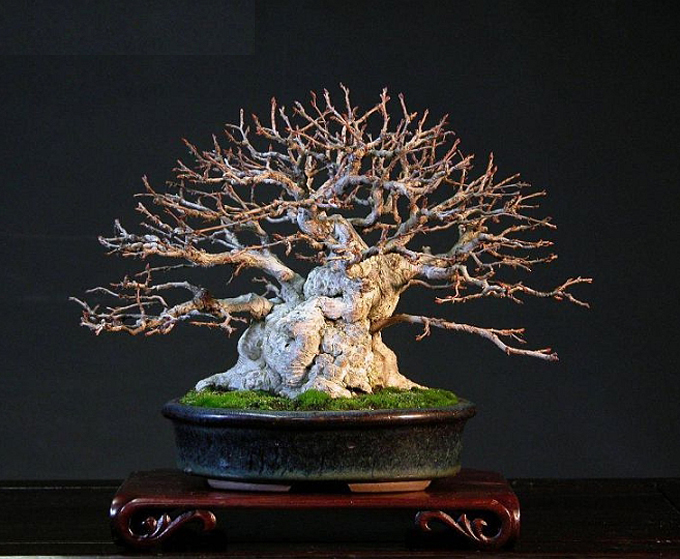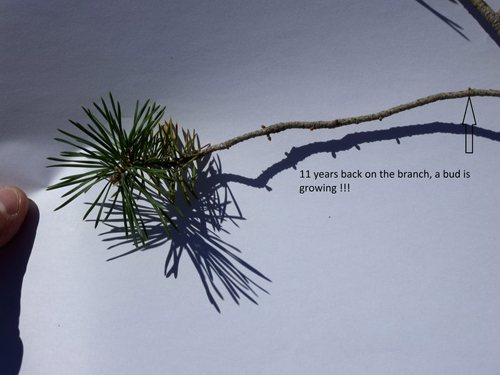 This shohin Carpinus coreana (Korean hornbeam) by Mario Komsta has appeared here on Bark before. As a companion plant no less (see below). No problem though. Any tree this good deserves to be shown more than once. Companion or by itself.
This shohin Carpinus coreana (Korean hornbeam) by Mario Komsta has appeared here on Bark before. As a companion plant no less (see below). No problem though. Any tree this good deserves to be shown more than once. Companion or by itself.

Speaking of Mario Komsta, this instructive photo about back budding, a lesser known benefit of fertilizing, is something he cooked up. I don’t remember where I found it (facebook?). It and the text below (edited just a bit) originally appeared here on Bark in October, 2010.
Fertilize! Skip ahead to the fourth point unless you are a beginner.
Many, if not most people under fertilize their bonsai. I imagine it’s laziness on some people’s part and ignorance on others (they’re related). There’s nothing we can do about the laziness part, but, maybe we can help with the ignorance.
First, we’ll state the obvious: fertilizing helps keep your bonsai healthy. Plants need a range of nutrients to sustain themselves, stay beautiful, help resist pests and disease and so forth.
Second, you don’t starve bonsai to keep them small. Bonsai are kept small by pruning (top and roots) and by growing them in small containers.
Third (you’d be surprised how many people don’t quite get this): fertilizing encourages growth and growth is critical in developing quality bonsai. You want trunks to thicken, branches to develop, nebari to develop, and so forth. Unhealthy plants don’t grow much, or worse, their growth is leggy and weak (Note from 2014: there’s a lot more to say about this, like what kind of fertilizer, when, how much and etc, but we can’t say everything in one post. If you search fertilizing on Bark and elsewhere you’ll find a wealth of information. Be careful though! Not everything you read is true).
Fourth (the purpose of the photo above): ample, (even intensive) fertilizing can encourage back budding (budding on old wood). Some trees don’t back bud easily (pines for example) so they need some encouragement. In the photo above, Mario points out a bud that popped up on eleven-year-old wood (on a pine no less!). He attributes this not very common occurrence to fertilizing.
Here’s a comment from the original post by someone named Mark: It doesn’t seem like 11 years old wood. And that’s exactly why the bud came out. Had the growth been strong, the wood would’ve mature and those sleeping buds would’ve had inactivated (for lack of a better word) long ago. Bottom line: it’s not an absolute age that’s the decisive factor. It’s all relative: one has to take other factors (besides age and fertilizing) into account.
 A great companion for a very good Red pine. Here’s the original caption from just over five years ago right here on Bark: The main tree in this display by Mario Komsta is a Japanese red pine (Pinus densiflora: Akamatsu in Japanese) and the secondary tree is a Korean hornbeam (Carpinus coreana: Iwashide in Japanese). The photo originally appeared in Bonsai Today issue 105 under the title; Dreams of Kokufu-ten – A Western Bonsai Artist Exhibits at Japan’s Most Prestigious Show.
A great companion for a very good Red pine. Here’s the original caption from just over five years ago right here on Bark: The main tree in this display by Mario Komsta is a Japanese red pine (Pinus densiflora: Akamatsu in Japanese) and the secondary tree is a Korean hornbeam (Carpinus coreana: Iwashide in Japanese). The photo originally appeared in Bonsai Today issue 105 under the title; Dreams of Kokufu-ten – A Western Bonsai Artist Exhibits at Japan’s Most Prestigious Show.